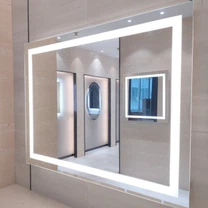What Is Electrically Heated Glass?
The electrically heated glass processing technology is to glue two or more pieces of tempered glass together with PVB or special film, and embed extremely thin tungsten wire or constantan wire and other metal electric heating wires on the side of the interlayer film of the laminated glass, or in the glass. The surface is coated with a transparent conductive film, which heats the glass after power on. The glass itself has a thermistor, which is connected to a temperature control system, and the surface temperature of the glass can be automatically adjusted and controlled, which has a certain degree of impact resistance. The temperature of the glass surface is as high as 40-60℃. The light transmittance is generally 80%.


Electrically Heated Glass Production Process
Since the production process of electrically heated glass is similar to that of laminated glass, currently domestically produced electrically heated glass can be roughly divided into three categories in terms of performance: monolithic electric heating, laminated electric heating, and hollow electric heating. The production process is as follows:
The electrically heated glass produced by the PVB autoclave is safety glass. Even if the glass is broken, no fragments will be splashed. The glass will not collapse after being broken, and it is not necessary to use toughened glass for production. The dissolution temperature of PVB film is above 90℃ and the melting point is high. It has good adhesion to inorganic glass (>5500N), and can be used indoors and outdoors without requirements for the use environment. It has high transparency (≥75%), low turbidity, heat resistance and cold resistance (-20℃~80℃) ), moisture resistance (>90%), and high mechanical strength. It is currently the best bonding material for laminated and safety glass in the world.
Advantages of Electrically Heated Glass
1. Excellent deicing function: the electrically heated glass is energized. The surface temperature rises (usually 40~60℃), so that the glass surface will not produce frost and condensation, and the voltage is safe, and there is no harm to the human body. The input voltage can be 110V, 220V, 230V, 240V (according to different countries Voltage to set), the output voltage can be 12V, 24V, 48V, 220V.
2. Excellent optical performance: The electrically heated glass uses conductive wire or conductive film as the heating medium to ensure that the glass has excellent light transmission performance and anti-distortion performance, which can achieve clear and true viewing through the glass.
3. Good safety: the laminated glass of the electric heating glass adopts tempered glass, which has high hardness and is not easy to break. Even if it encounters gravity impact, the glass fragments will have organic mucosa sticking, and will not splash around and hurt people.
4. Anti-ultraviolet radiation function: Electrically heated glass is used in high-end automobiles. The glass has high ultraviolet absorption capacity, which can effectively block ultraviolet rays from entering people's rooms and reduce the damage of ultraviolet rays to drivers and indoor facilities.






